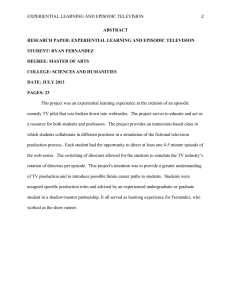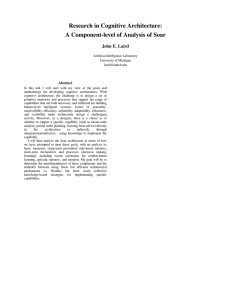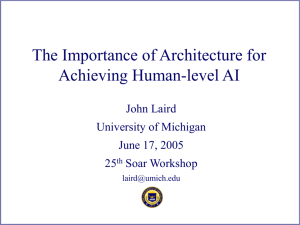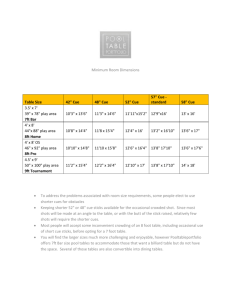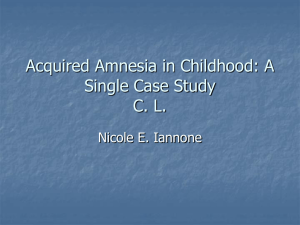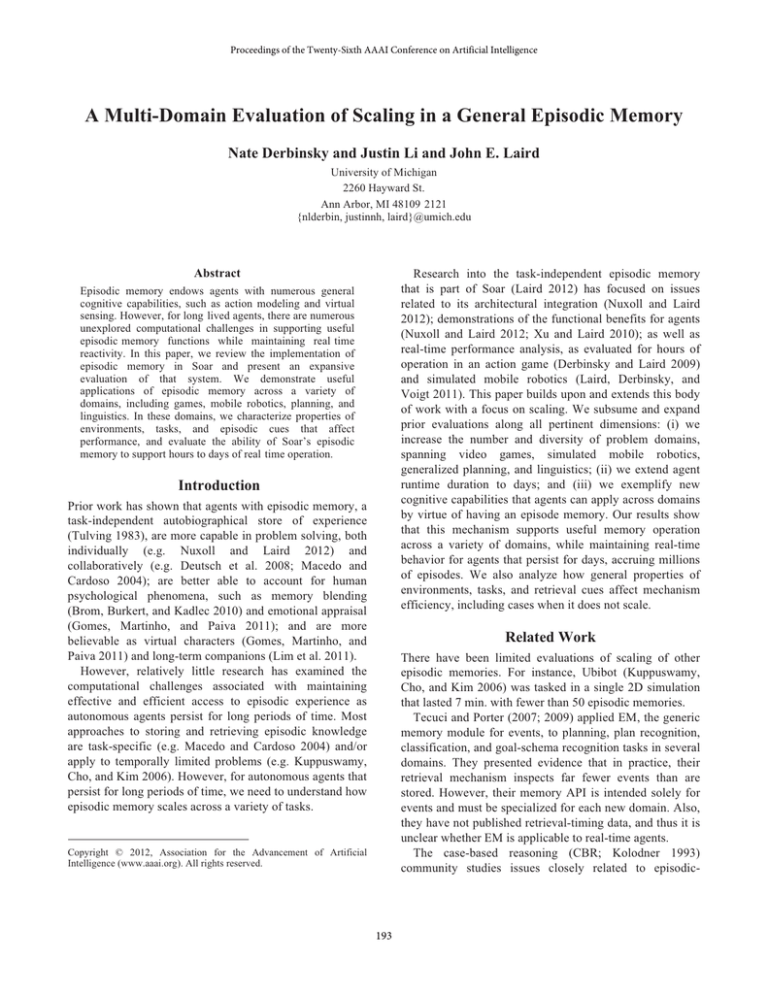
Proceedings of the Twenty-Sixth AAAI Conference on Artificial Intelligence
A Multi-Domain Evaluation of Scaling in a General Episodic Memory
Nate Derbinsky and Justin Li and John E. Laird
University of Michigan
2260 Hayward St.
Ann Arbor, MI 48109 2121
{nlderbin, justinnh, laird}@umich.edu
Research into the task-independent episodic memory
that is part of Soar (Laird 2012) has focused on issues
related to its architectural integration (Nuxoll and Laird
2012); demonstrations of the functional benefits for agents
(Nuxoll and Laird 2012; Xu and Laird 2010); as well as
real-time performance analysis, as evaluated for hours of
operation in an action game (Derbinsky and Laird 2009)
and simulated mobile robotics (Laird, Derbinsky, and
Voigt 2011). This paper builds upon and extends this body
of work with a focus on scaling. We subsume and expand
prior evaluations along all pertinent dimensions: (i) we
increase the number and diversity of problem domains,
spanning video games, simulated mobile robotics,
generalized planning, and linguistics; (ii) we extend agent
runtime duration to days; and (iii) we exemplify new
cognitive capabilities that agents can apply across domains
by virtue of having an episode memory. Our results show
that this mechanism supports useful memory operation
across a variety of domains, while maintaining real-time
behavior for agents that persist for days, accruing millions
of episodes. We also analyze how general properties of
environments, tasks, and retrieval cues affect mechanism
efficiency, including cases when it does not scale.
Abstract
Episodic memory endows agents with numerous general
cognitive capabilities, such as action modeling and virtual
sensing. However, for long lived agents, there are numerous
unexplored computational challenges in supporting useful
episodic memory functions while maintaining real time
reactivity. In this paper, we review the implementation of
episodic memory in Soar and present an expansive
evaluation of that system. We demonstrate useful
applications of episodic memory across a variety of
domains, including games, mobile robotics, planning, and
linguistics. In these domains, we characterize properties of
environments, tasks, and episodic cues that affect
performance, and evaluate the ability of Soar’s episodic
memory to support hours to days of real time operation.
Introduction
Prior work has shown that agents with episodic memory, a
task-independent autobiographical store of experience
(Tulving 1983), are more capable in problem solving, both
individually (e.g. Nuxoll and Laird 2012) and
collaboratively (e.g. Deutsch et al. 2008; Macedo and
Cardoso 2004); are better able to account for human
psychological phenomena, such as memory blending
(Brom, Burkert, and Kadlec 2010) and emotional appraisal
(Gomes, Martinho, and Paiva 2011); and are more
believable as virtual characters (Gomes, Martinho, and
Paiva 2011) and long-term companions (Lim et al. 2011).
However, relatively little research has examined the
computational challenges associated with maintaining
effective and efficient access to episodic experience as
autonomous agents persist for long periods of time. Most
approaches to storing and retrieving episodic knowledge
are task-specific (e.g. Macedo and Cardoso 2004) and/or
apply to temporally limited problems (e.g. Kuppuswamy,
Cho, and Kim 2006). However, for autonomous agents that
persist for long periods of time, we need to understand how
episodic memory scales across a variety of tasks.
Related Work
There have been limited evaluations of scaling of other
episodic memories. For instance, Ubibot (Kuppuswamy,
Cho, and Kim 2006) was tasked in a single 2D simulation
that lasted 7 min. with fewer than 50 episodic memories.
Tecuci and Porter (2007; 2009) applied EM, the generic
memory module for events, to planning, plan recognition,
classification, and goal-schema recognition tasks in several
domains. They presented evidence that in practice, their
retrieval mechanism inspects far fewer events than are
stored. However, their memory API is intended solely for
events and must be specialized for each new domain. Also,
they have not published retrieval-timing data, and thus it is
unclear whether EM is applicable to real-time agents.
The case-based reasoning (CBR; Kolodner 1993)
community studies issues closely related to episodic-
Copyright © 2012, Association for the Advancement of Artificial
Intelligence (www.aaai.org). All rights reserved.
193
memory research, including the use of past experience with
present reasoning and learning, as well as scaling to large
case libraries (Smyth and Cunningham 1996). However,
most CBR systems optimize performance for a specific
task, and specialize case format, storage, retrieval, and
adaptation. By contrast, this paper focuses on a taskindependent mechanism applied in a variety of domains.
Functional Integration
Episodic memory comprises three phases: (1) encoding
agent state; (2) storing this information as episodic
knowledge; and (3) supporting retrieval at a later time.
During each decision cycle, Soar’s episodic memory
automatically encodes the contents of working memory as
a connected di-graph. This information, as well as the time
of encoding, is stored in episodic memory, where it
remains without modification for the lifetime of the agent.
To retrieve an episode, rules fire to construct an episodic
cue: a directed, connected, acyclic graph that specifies
task-relevant relations and features. The cue-matching
process identifies the “best” matching episode, defined as
the most recent episode that has the greatest number of
structures in common with cue leaf nodes. Episodic
memory then reconstructs this episode in working memory.
This formulation of cue matching commits to two
algorithmic properties that affect scaling. The process
returns an episode if one exists that contains at least one
feature in common with a cue leaf node. The mechanism
also returns the “best” episode with respect to cue
structure, leaf nodes, and temporal recency. Given these
commitments, in the worst case, the encoding, storage, and
retrieval operations scale at least linearly with the number
of state changes. The implementation takes advantage of
regularities in state representations and dynamics to reduce
the frequency of this worst case.
Episodic Memory in Soar
Soar is a cognitive architecture that has been used for
developing intelligent agents and modeling human
cognition (Laird 2012). We first describe pertinent
architectural mechanisms and processes, and then convey
how episodic memory is efficiently integrated.
The Soar Cognitive Architecture
In Soar, the agent’s current state is represented in a
symbolic, short-term working memory. It is here that
perception, goals, retrievals from long-term memory
(including episodic), external action directives, and
structures from intermediate reasoning are jointly
represented as a connected, directed graph – an encoding
that is sufficiently expressive for a wide variety of tasks.
Procedural long-term memory holds the agent’s
knowledge of when and how to perform actions, both
internal, such as querying long-term memories, and
external, such as initiating robotic actuators or virtual game
character actions. Procedural knowledge is represented as
if-then rules: the conditions test patterns in working
memory and the actions add and/or remove workingmemory structures. Agents retrieve knowledge from either
of the declarative long-term memories (semantic and
episodic) by constructing a cue in working memory; the
intended long-term memory interprets the cue, searches its
store for the “best” match, and reconstructs the associated
knowledge in working memory. Soar has other memories
and processing mechanisms; however, they are not
pertinent to this paper and are not discussed further.
Agent reasoning in Soar consists of a sequence of
decision cycles to select operators, which perform actions
in service of the agent’s goal(s). The time to execute the
decision cycle, which, in practice, primarily depends on the
speed with which the architecture can retrieve knowledge
from long-term memory, determines agent reactivity. Thus,
the degree to which long-term memory operations can
scale to large amounts of knowledge over long lifetimes
directly affects the ability of the agent to act in real time.
Efficient Implementation
Soar’s episodic memory exploits two assumptions about
agent state, both of which relate to those that have been
successfully applied in the rule-matching literature. The
first is temporal contiguity: the world changes slowly, and
thus changes to agent state, from episode-to-episode, will
be few relative to the overall size of state. The second is
structural regularity: for agent knowledge to generalize, it
must reuse representational structure, and thus, over time,
the number of distinct structures will be much smaller than
the total number of experienced structures.
Episodic encoding and storage draw directly from these
assumptions. Soar represents episodic knowledge in two
data structures: (1) a global structure index, termed the
Working Memory Graph (WMG), which captures all
distinct graph structures that have been encoded, and (2) a
set of temporal intervals that capture when each edge of the
WMG was added to/removed from working memory.
These data structures comprise a dynamic-graph index.
Cue matching is a constrained form of sub-graph
isomorphism: to score an episode, the mechanism must
compare two rooted, directed, connected graphs (where the
cue is acyclic). To avoid this potentially combinatorial
comparison, Soar’s implementation utilizes a two-phase
matching process (Forbus, Gentner, and Law 1995): a
relatively cheap surface match identifies, in reverse
Episodic Memory
This section summarizes the functional commitments
(Nuxoll and Laird 2012) of Soar’s episodic memory, as
well as its implementation (Derbinsky and Laird 2009).
194
temporal order, each episode that contains all cue leaf
nodes independently and submits it to a more expensive
structure match. Structural unification is implemented as
graph matching with standard heuristics (e.g. MCV). The
surface matcher, however, attempts to exploit the
aforementioned assumptions and indexing.
First, the WMG indexes to only those temporal intervals
that refer to cue features. The endpoints of these intervals
are then walked in order of decreasing recency to identify
and evaluate only those episodes during which pertinent
features changed: temporal contiguity predicts that existing
structures will tend to persist, and thus examining structure
changes should require much less effort than examining
individual episodes. This process scales with the temporal
selectivity of the cue: in the worst case it must examine all
episodes sharing features with the cue, which may be all
episodes in the store, but it may be a much smaller
proportion. This endpoint-walking process terminates
when an episode unifies structurally.
Surface match, with respect to a cue, can be formulated
as computing satisfaction of a disjunctive-normal-form
(DNF) Boolean statement, where variables map to cue
nodes, clauses map to root-to-leaf paths, and literals map to
feature existence within episodes. In order to efficiently
evaluate DNF satisfaction between discrete graph changes,
a discrimination network, termed the DNF Graph, is used
to maintain state between episode evaluations, and
selectively propagate changes in the cue, similar to a Rete
network (Forgy 1982). Given a DNF Graph and a feature
change, evaluating an episode scales with the structural
selectivity of the feature: in the worst case it must examine
all structures in the episode that could map to the feature in
the cue, which may be the size of the episode, or any
fraction thereof.
Once the cue-matching process selects an episode to
retrieve, the system uses a relational interval tree (Kriegel,
Pötke, and Seidl 2000) to efficiently extract all features and
relations of the episode from the dynamic-graph index.
matching (i.e. the time for retrieval, without reconstructing
episodes in Soar’s working memory). We report maximum
time: whereas average time can mask momentary
computation “surges,” the maximum captures the agent’s
ability to respond under algorithmically stressful
circumstances. We compare this metric to a reactivity
threshold of 50 msec., a response time that is sufficient for
real-time control in games, robotics, and HCI tasks.
Since memory becomes an important factor for long
runs of agents, we measure the amount of memory used by
episodic memory. We also relate this measure to the
average size of and changes to working memory.
To reliably measure cue-matching timing data, we
instrumented Soar v9.3.1 [http://sitemaker.umich.edu/soar]
to perform this operation 100 times for each cue at regular
intervals across the lifetime of the agent. Storage timing
data, however, only captures a single operation, and is thus
noisier and we can only extract qualitative trends. All
experiments were performed on a Xeon L5520 2.26GHz
CPU with 48GB RAM running 64-bit Ubuntu v10.10.
Evaluated Capabilities
For each evaluation domain, we developed a specialized
set of cues that implemented a set of cognitive capabilities,
or high-level functionalities supported by episodic memory
(Nuxoll and Laird 2012). The following are the full set of
capabilities that we include in this evaluation:
Virtual Sensing. An agent retrieves past episodes that
include sensory information beyond its current perceptual
range that are relevant to the current task.
Detecting Repetition. An agent retrieves past episodes
that are identical (or close to identical), possibly indicating
a lack of progress towards goal(s).
Action Modeling. An agent retrieves an episode of
performing an action and compares that episode to one or
more episodes that followed to model action consequences.
Environmental Modeling. An agent retrieves an episode
and compares that episode to episodes that followed to
model world dynamics, independent of its own actions.
Empirical Evaluation
Our goal is to understand the degree to which Soar’s
episodic memory supports useful operation across a variety
of domains while scaling to long agent lifetimes.
Explaining Behavior. An agent replays episodes of its
behavior to explain its behavior to itself or others.
Managing Long-Term Goals. An agent retrieves goals
that were initiated in the past but are not currently active,
to determine if they should be active in the current context.
Evaluation Metrics
In order to evaluate episodic-memory scaling, we measure
two classes of computational-resource usage during agent
runs: execution time and storage requirements.
The time it takes for Soar to complete a decision cycle
dictates the rate at which it can respond to environmental
change, and is thus a direct measure of agent reactivity. We
instrumented Soar to directly measure time required for
encoding/storing episodes, as well as performing cue
Predicting Success/Failure. An agent replays episodes to
estimate the value of an action with respect to task goals.
Empirical Results
For each evaluation domain, we describe the properties of
the task and agent, related work, the set of cues developed
for the task, and empirical results.
195
five times across SemCor (4.6M episodes). We measured
the storage and retrieval performance every 50K episodes.
All operations met our reactivity criteria (<50 msec.).
Maximum storage time was essentially constant, with a
maximum of 0.5 msec. The maximum query time, across
all 11 cues, was 22.05 msec. We regressed a model that
predicts cue-matching time in msec., as a linear factor of
the number of interval endpoints walked (r2>0.999):
0.0024x + 0.0647. This model predicts that retrieval time,
in this task, is dependent almost exclusively on interval
walking; we estimate scaling by computing the number of
endpoints walked when the function value equals 50 msec.
(20,806). If we assume one word per episode, Soar’s
episodic memory can perform cue matching that examines
11.23% of SemCor (total = 185,269 words). We now
examine how this scaling limit compares to the space of
possible cues, and the evaluation cues we used in this task.
In SemCor, only two words occur more frequently than
in 1% of inputs: “be” (4.53%) and “person” (3.61%). Thus,
Soar’s episodic memory can reactively respond to any
individual feature as a cue. However, as cue size increases,
the number of potential endpoints to walk increases
additively with each word, while co-occurrence frequency,
the number of times the n-gram occurs within the corpus,
can only stay constant or decrease. For instance, consider
the following two phrases used for our cue evaluation:
{Friday, say, group} and {well, be, say}. The endpoint and
co-occurrence frequency data of all 1-, 2, and 3-grams of
these phrases is in Table 1, where the final column is
(endpoints/occurrence) divided by the size of SemCor,
estimating the proportion likely to be examined for each
cue (assuming uniform distribution of occurrence). For 1grams, Soar achieves constant-time cue matching,
independent of this data, since it concludes cue matching
after the first match. For those n-grams with a cooccurrence of 1, cue-matching time exhibits saw-tooth
patterns, where peaks are once-per-corpus exposure, since
the number of endpoints to examine increases until the ngram is re-encountered. For non-zero co-occurrence, we
see more frequent, non-uniform heights in the data, as the
n-grams are encountered through the corpus. Soar’s
episodic memory can perform this task reactively for 1grams, 2-grams, and 3-grams, as SemCor proportion for all
cues of these lengths is below 11.23%. However, of the
more than 184,000 distinct 4-grams in this corpus, there
are 368 that examine more than 11.23% of SemCor, and
thus a 4-gram is the scaling limit.
Word Sense Disambiguation
An important problem for any agent that uses natural
language is word sense disambiguation (WSD) – the task
of determining the meaning of words in context. We
extend prior work that explored the degree to which
memory-retrieval bias was beneficial in WSD (Derbinsky
and Laird 2011). In this formulation, the agent perceives a
<lexical word, part-of-speech> pair, such as <“say”, verb>,
and, after attempting to disambiguate the word, the agent
receives all word meanings that were appropriate in that
context. To measure the benefit of memory in this task, the
agent perceives the corpus, in order, numerous times, and
is evaluated on learning speed and accuracy.
For this task, we implemented an agent that represents
the last n lexical-word inputs as an n gram. The agent then
uses a sequence of episodic cognitive capabilities to form a
disambiguation: first, it cues episodic memory to detect a
repeated situation (e.g. “when did I last perceive the 3gram {Friday, say, group}?”); it then retrieves the next
episode, forming an environmental model of feedback (e.g.
“what happened when I replied ‘express a supposition’?”);
and then disambiguates using this prior information,
predicting future success based upon prior experience.
We evaluated the agent using SemCor (Miller et al.
1993), the largest and most widely used sense-tagged
corpus. During its first exposure to the corpus, the agent
can disambiguate 14.57% of words using a 2-gram
representation, and 2.32% using 3-grams. In the next
exposure, these performance levels improve to 92.82% and
99.47%, respectively. These results show the benefit of
flexible access to a high-fidelity store of experience.
This domain is small, on average requiring 234 bytes of
memory to store the working-memory changes in each
episode. However, as with all natural-language texts, there
are some words that appear more often than others in
SemCor, and so this task exemplifies the effects of
temporal selectivity and cue-feature co-occurrence.
To evaluate scaling, we selected two 3-word phrases
from the corpus and used a set of cues that represented all
1-, 2-, and 3-gram contexts for these phrases (11 cues total,
as one word was common; see Table 1). We ran the agent
Table 1. WSD: occurrence and cue endpoints for SemCor.
n Gram
Occurrence Endpoints Proportion
{group}
1,333
1,333
~ 0%
{say}
1,005
1,005
~ 0%
{Friday}
18
18
~ 0%
{well}
150
150
~ 0%
{be}
8,400
8,400
~ 0%
{say, group}
6
2,338
0.21%
{Friday, say}
1
1,023
0.55%
{Friday, say, group}
1
2,356
1.27%
{be, say}
69
9,405
0.07%
{well, be}
27
8,550
0.17%
{well, be, say}
1
9,555
5.16%
Generalized Planning
In WSD, temporal selectivity of cues was the primary
factor affecting performance, whereas cue size and
structure had little effect. To evaluate cue complexity, we
extended prior work that used episodic memory as a source
of action-modeling knowledge for planning (Xu and Laird
196
matching. These findings suggest that Soar’s episodic
memory is not appropriate for direct analogical mapping.
Our final experiment explored whether episodic memory
could be used to detect analogous states if the agent had
knowledge of important schemas at the time of encoding.
This experiment relates to prior work showing that experts
are able to encode memories that can be relationally
retrieved (Gentner et al. 2009). We encoded the cues from
our second experiment, those without grounded features, as
rules that would place a flag in working memory whenever
the pattern appeared, a feature episodic memory would
automatically encode and could be queried for directly.
Soar’s episodic memory could scale to 50K episodes in all
problem instances given this task formulation (max. < 0.08
msec.), suggesting agents can perform limited analogical
reasoning over large stores of prior experience, while
remaining reactive, by joining task-dependent recognition
knowledge with a task-independent episodic memory.
2010). In this evaluation, we used 12 planning domains,
common in competitions (Logistics, Blocksworld, Eight
puzzle, Grid, Gripper, Hanoi, Maze, Mine Eater, Miconic,
Mystery, Rockets and Taxi) and made 44 problem instances
by varying domain parameters (e.g. number of blocks in
Blocksworld). The agent’s state captures a set of objects
and relations, and the agent has rules that encode the
actions it can take. At each episode, the agent randomly
selects an action, exploring the state space over time.
Our first experiment explored whether episodic memory
could detect repeated states. For each problem instance,
we extracted a random problem state as our evaluation cue.
We then ran the agent for 50K episodes, and measured
performance every 1K episodes as it explored the state
space. This experiment evaluates Soar’s episodic memory
while stressing the dimension of structural selectivity: in
these domains, the cue is relatively large and the agent
state is structurally homogenous, and thus cues match
multiple structures in most other episodes.
Soar’s episodic memory reactively stored episodes in all
problem instances (maximum < 12.04 msec.). Memory
consumption in each domain was strongly correlated with
the number of working-memory changes (r2=0.86): storage
ranged from 562 bytes per episode to 5454, averaging
1741. Using the full 48GB of RAM on our evaluation
computer, we could thus store between 9 and 91 million
episodes, with more than 29M on average. In summary,
storage is not a scaling concern in this set of domains.
Of the 44 problem instances, there were 12 in which cue
matching remained reactive for the full 50K episodes, all
of which were instances of the Miconic, Maze, Hanoi, and
Gripper domains. These problem instances did not exhibit
growth in their cue-matching time, while the remaining
problem instances grew rapidly and became unreactive in
fewer than 10k episodes. When we explored the data for
explanatory factors, we found that retrieval time within
each domain strongly correlated with the number of
episodes searched and working-memory size (r2=0.85).
The 12 problem instances that did scale have the smallest
average working-memory sizes, as well as relatively small
state search spaces (yielding small, bounded interval
searches). The remaining instances were either too
structurally unselective, too temporally unselective (due to
a large state space), or both. These results characterize an
upper bound in cue complexity for reactive retrievals.
Our second experiment explored whether episodic
memory could be used to detect analogous states. We used
the same setup as in the previous experiment, but removed
all grounded features in the evaluation cues. However, this
had the effect of making the cues less structurally selective
(i.e. each cue feature could match more structures when
compared to an episode). As a result, Soar’s episodic
memory could not scale on any problem instance,
primarily due to frequent and expensive structural
Video Games & Mobile Robotics
The previous evaluations focused on specific aspects of
episodic-retrieval cues: WSD stressed temporal selectivity,
while the planning domains stressed structural complexity.
We found that Soar’s episodic memory has scaling limits
that depend on domain structure and dynamics, knowledge
representation, and cues. Here we examine the degree to
which these limitations apply to domains in which agent
actions impact its future perceptions of the world. We
describe the domains, and then present combined results.
TankSoar. TankSoar is a video game that has been used in
evaluating numerous aspects of Soar, including episodic
memory (Derbinsky and Laird 2009; Nuxoll and Laird
2012). In TankSoar, the agent controls a tank and moves in
a discrete 15x15 maze. The agent has numerous sensors,
including path blockage and radar feedback, and it can
perform actions that include turning, moving, and
controlling its radar. The agent we use, mapping bot,
explores the world and populates an internal map, stored in
working memory, which averages 2734 structures.
This task is interesting for episodic-memory evaluation
due to a large working memory with relatively few
changes (~23 per decision). However, most perceptual
structures change frequently and many are highly selective,
both temporally and structurally.
We used 15 cues in TankSoar, many developed in prior
work (Derbinsky and Laird 2009). These cues
implemented virtual-sensing, detecting-repetition, and
action-modeling capabilities. For example:
1. “When did I last sense a missile pack on my radar?”
2. “When was I last at this (x, y) position on my map?”
3. “What happened last time I rotated left and turned on my
radar while I was blocked in the forward direction?”
Cues that referred to a map cell (e.g. #2) were structurally
unselective, as they could refer to any of the 225 entries.
197
TankSoar
Eaters
Infinite Mario
Mobile Robotics
Table 2. Empirical results for video games and mobile robotics.
Storage
Cue Matching (Max. Time in msec.)
Max. Time (msec)
Avg. Bytes/Episode
High Selectivity
Low Selectivity
18.66
1,035
4.77
18.31
1.39
813
0.71
55.01
2,646
1.66
40.43
3.17
113
0.75
27.50
a relatively large percentage of the visual scene in changes
between episodes (avg. 73), stressing temporal contiguity.
We evaluated 14 virtual-sensing and action-modeling
cues. For example, the following cue combines perceptual
features with those derived from task knowledge: “What
did I do when last I encountered a winged, downwardflying ‘Goomba’ that was a threat?” Cues that virtually
sensed visual-scene cells were structurally unselective. We
ran the agent for 3.5M episodes (>48 hours, SRT) and
measured performance every 50K.
The temporal selectivity of cues relating to perceptual
structures was typically reduced as the cue size increased,
due to non-overlap in feature co-occurrence (e.g. in #1
there were episodes when the agent used the radar, but did
not sense a missile pack). We ran mapping-bot for 3.5M
episodes, which is >48-hours of simulated real-time (SRT:
50 msec./episode), and measured performance every 50K.
Eaters. Eaters has also been used in previous episodicmemory evaluations. Eaters is a video game, similar to
PAC-MAN, where the agent controls an “eater,” which
moves through a 15x15 grid-world, eating different types
of food. The agent senses a 2-cell radius, and can move in
any of the four cardinal directions. The agent we use,
advanced move, prioritizes movement based on food types.
This task is interesting as a contrast to TankSoar. The
agent’s working-memory size is drastically smaller (230
structures), but changes are comparable (~19 per decision).
We used 7 cues that exemplified virtual sensing, detecting
repetition, action modeling, and explaining behavior. For
instance: “What happened the last time there was normal
food to the east of me and bonus food to the west of me?”
Examining the episode following this retrieval supports the
agent explaining its own preferences regarding the relative
desirability of these food types, informing predictions of its
own future decisions. The agent state is sufficiently simple
such that no evaluation cue was unselective, either
structurally or temporally. We ran advanced-move for
3.5M episodes (>48 hours, SRT) and measured every 50K.
Mobile Robotics. For this evaluation, we used an existing
mobile-robotics platform that has been applied to
simulation and physical hardware (Laird, Derbinsky, and
Voigt 2011). The agent perceives both physical perception
data, including real-valued abstractions of laser rangefinder data, as well as symbolic representations of objects,
rooms, and doorways. The task is to explore a building
with 100 offices, and then execute a fixed-patrol pattern.
While performing these tasks, the agent builds an internal
map, which it uses for path planning and navigation. The
average working-memory size is 1235, with 2 changes.
We evaluated 6 cues for virtual sensing and goal
management. Consider the following cue: “When was my
desired destination doorway #5?” The agent could examine
episodes that followed to recall progress made towards that
goal. However, as the agent accumulated more distinct
goals, this cue became less temporally selective. We did
not evaluate any structurally unselective cues in this task.
We ran the agent in simulation for 12 hours of real time,
measuring performance every 300K episodes (~2 min.).
Infinite Mario. Infinite Mario is a video game used in the
2009 Reinforcement-Learning (RL) Competition and is
based on Super Mario. The allocentric visual scene
comprises a two-dimensional matrix (16x22) of tiles and
the agent can take actions that include moving, jumping,
and increasing speed. We use an agent that applies an
object-oriented representation and hierarchical RL to
quickly improve performance in the task (Mohan and Laird
2011) and collect data on game level 0.
Several aspects of this game are interesting for
evaluation. The working memory is large (~2000) and
contains a variety of representational patterns, including
flat features that are both symbolic (e.g. Mario is “small,”
“big,” or “fiery”) and real-valued (e.g. distance to
enemies); hyper-edges (e.g. rows in the visual scene); and
relational structures (e.g. relating hierarchical state
representations to perception). Also, due to side-scrolling,
Results. The left half of Table 2 presents storage results,
grouped by domain. Soar stored episodes in less than 50
msec. for all domains except Infinite Mario, where
infrequent spikes in perceptual changes, caused by Mario
dying and restarting the level, defied the temporalcontiguity assumption. The storage cost across domains
correlated with working-memory changes (r2>0.93).
The right half of Table 2 presents cue-matching results,
grouped by domain and cue selectivity (temporal or
structural). Soar maintained reactivity across all domains.
With one exception, retrieval time did not meaningfully
increase with time. The growth rate for goal management
in mobile robotics (see Figure 1) depended upon the
properties of the robot’s mission: when behavior shifted
from exploration to patrol (~10M episodes), new goal
198
Deutsch, T., Gruber, A., Lang, R., Velik, R. 2008. Episodic
Memory for Autonomous Agents. In Proc. of the 5th Intl. Conf.
on Human System Interaction, 621 626.
Forbus, K., Gentner, D., Law, K. 1995. MAC/FAC: A Model of
Similarity based Retrieval. Cognitive Science 19 (2): 141 205.
Forgy, C. L. 1982. Rete: A Fast Algorithm for the Many
Pattern/Many Object Pattern Match Problem. Artificial
Intelligence 19 (1): 17 37.
Gentner, D., Loewenstein, J., Thompson, L., Forbus, K. D. 2009.
Reviving Inert Knowledge: Analogical Abstraction Supports
Relational Retrieval of Past Events. Cognitive Science 33: 1343
1382.
Gomes, P. F., Martinho, C., Paiva, A. 2011. I’ve Been Here
Before! Location and Appraisal in Memory Retrieval. In Proc. of
the 10th Intl. Conf. on Autonomous Agents and Multiagent
Systems, 1039 1046.
Kolodner, J. 1993. Case Based Reasoning. Morgan Kaufmann.
Kriegel, H., Pötke, M., Seidl, T. 2000. Managing Intervals
Efficiently in Object Relational Databases. In Proc. of the 26th
Intl. Conf. on Very Large Databases, 407 418.
Kuppuswamy, N. S., Cho, S., Kim, J. 2006. A Cognitive Control
Architecture for an Artificial Creature Using Episodic Memory.
In Proc. of the 3rd SICE ICASE Intl. Joint Conf., 3104 3110.
Laird, J. E. 2012. The Soar Cognitive Architecture. MIT Press.
Laird, J. E., Derbinsky, N., Voigt, J. R. 2011. Performance
Evaluation of Declarative Memory Systems in Soar. In Proc. of
the 20th Behavior Representation in Modeling & Simulation
Conf., 33 40.
Lim, M. Y., Aylett, R., Vargas, P. A., Ho, W. C., Dias, J. 2011.
Human like Memory Retrieval for Social Companions. In Proc.
of the 10th Intl. Conf. on Autonomous Agents and Multiagent
Systems, 1117 1118.
Macedo, L., Cardoso, A. 2004. Exploration of Unknown
Environments with Motivational Agents. In Proc. of the 3rd Intl.
Joint Conf. on Autonomous Agents and Multiagent Systems, 328
335.
Miller, G. A., Leacock, R., Tengi, R., Bunker, R. T. 1993. A
Semantic Concordance. In Proc. of the Workshop on Human
Language Technology, 303 308.
Mohan, S., Laird, J. E. 2011. An Object Oriented Approach to
Reinforcement Learning in an Action Game. In Proc. of the 7th
AAAI Conf. on Artificial Intelligence and Interactive Digital
Entertainment, 164 169.
Nuxoll, A. M., Laird, J. E. 2012. Enhancing Intelligent Agents
with Episodic Memory. Cognitive Systems Research 17 18, 34 48.
Smyth, B., Cunningham, P. 1996. The Utility Problem Analysed:
A Case Based Reasoning Perspective. In Proc. of Advances in
Case Based Reasoning, 3rd European Workshop, 1560 1565.
Tecuci, D., Porter, B. 2007. A Generic Memory Module for
Events. In Proc. of the 20th Florida Artificial Intelligence
Research Society Conf., 152 157.
Tecuci, D., Porter, B. 2009. Memory Based Goal Schema
Recognition. In Proc. of the 22nd Florida Artificial Intelligence
Research Society Conf., 111 117.
Tulving, E. 1983. Elements of Episodic Memory. Oxford:
Clarendon Press.
Xu, J. Z., Laird, J. E. 2010. Instance Based Learning of
Deterministic Relational Action Models. In Proc. of the 24th
AAAI Conf. on Artificial Intelligence, 1574 1579.
Figure 1. Mobile robotics timing data for goal management cue.
locations were encoded less frequently, and temporal
selectivity decreased at a smaller rate. At its original rate,
cue-matching time would grow beyond 50 msec. after 34M
episodes; afterwards it would last nearly 634M (>3 days).
Discussion
Our goal in this paper was to evaluate the degree to which
Soar’s episodic memory supports useful operation across a
variety of domains while scaling to long agent lifetimes.
We presented evidence that in linguistics, planning, video
games, and mobile robotics, it supports many useful
capabilities while maintaining reactivity. However, we
have also shown that the functional commitments of Soar’s
episodic memory lead to a mechanism that is not immune
to properties of domains and cues. For example, the WSD
and mobile-robotics domains illustrate how the temporal
selectivity and co-occurrence of cue features can lead to
searches that scale linearly with time. Also, attempting to
match temporally unselective cues in structurally
homogenous domains, such as planning problems, can
cause cue matching to scale with cue and/or state size.
These findings will inform the development and evaluation
of future episodic-memory implementations.
Acknowledgments
We acknowledge the funding of the Air Force Office of
Scientific Research, contract FA2386-10-1-4127, and the
Office of Naval Research, contract N00014-08-1-0099.
References
Brom, C., Burkert, O., Kadlec, R. 2010. Timing in Episodic
Memory for Virtual Characters. In Proc. of the IEEE 2010 Conf.
on Computational Intelligence and Games, 305 312.
Derbinsky, N., Laird, J. E. 2009. Efficiently Implementing
Episodic Memory. In Proc. of the 8th Intl. Conf. on Case Based
Reasoning, 403 417.
Derbinsky, N., Laird, J. E. 2011. A Functional Analysis of
Historical Memory Retrieval Bias in the Word Sense
Disambiguation Task. In Proc. of the 25th AAAI Conf. on
Artificial Intelligence, 663 668.
199

